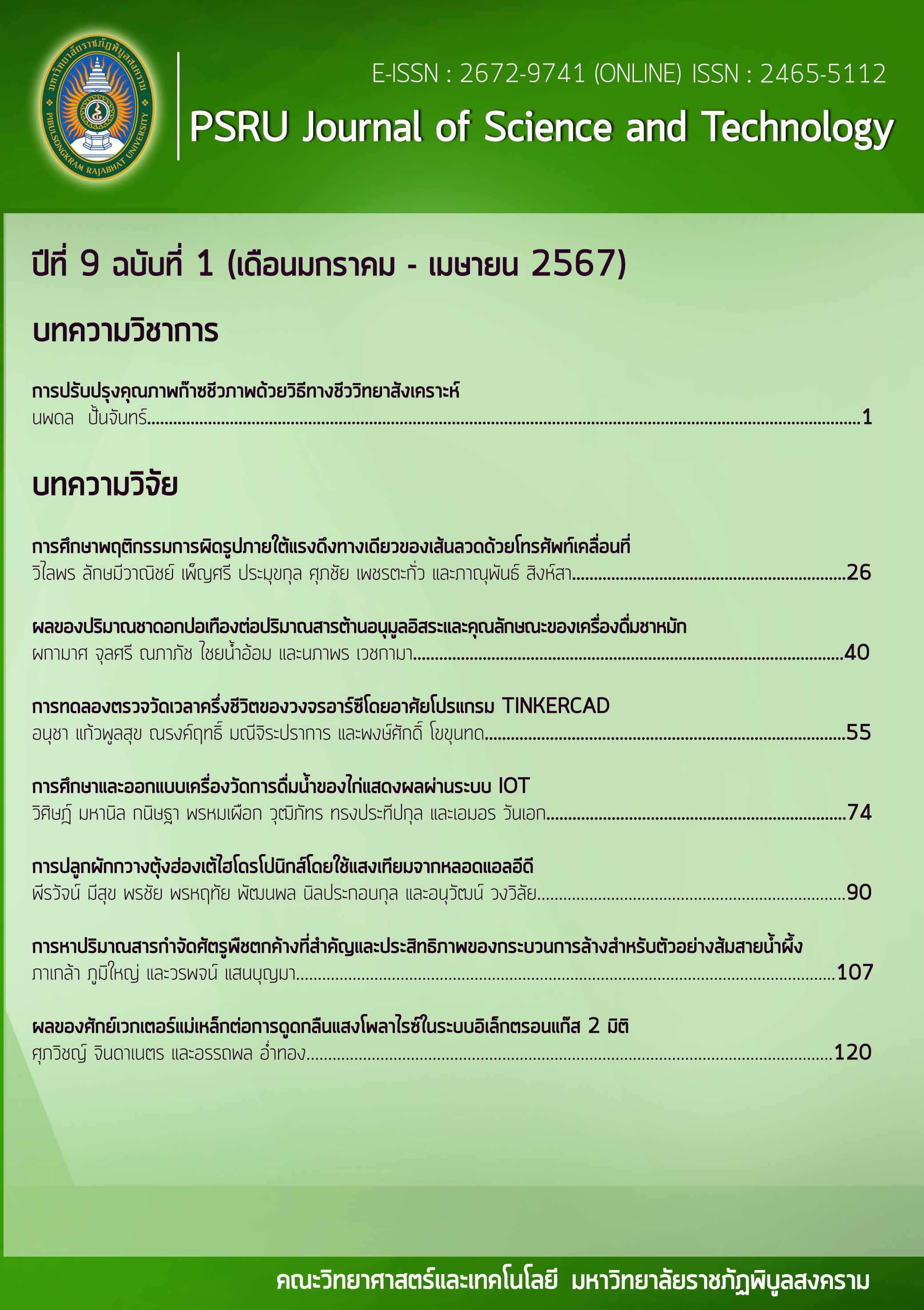DETERMANATION OF MAJOR PESTICIDE AND EFFICIENCY OF WASHING FOR ORANGE (SAI NAM PHUENG) SAMPLE
Keywords:
Pesticide, Washing efficiency, Sai Nam PhuengAbstract
This research aimed to determine the qualitative and quantitative of the pesticide residues in Sai Nam Phueng oranges and investigated the efficiency of four washing methods. The washing methods included soaking water, saline, vinegar and sodium carbonate, respectively. The extracted samples by QuEChERS method were analyzed by Gas Chromatography-Mass Spectrometry/ Mass Spectrometry (GC-MS/MS) and Liquid Chromatography-Mass Spectrometry/ Mass Spectrometry (LC-MS/MS) techniques. The 3 groups of pesticide residues were found, 1) Ethion and Profenofos of Organophosphate groups, 2) 3-Hydroxy Carbofuran, Fenobucarb and Carbofuran of Carbamate groups and 3) Bifenthrin, Cyfluthrin and L-Cyhalothrin of Pyrethroid groups. The significant was differed of the 4 washing methods effectiveness was showed at p 0.05. Sodium carbonate washing method was the most effective regarded to eliminate pesticide residues of organophosphate group. Saline washing was showed the most effective for carbamate group and vinegar washing method was most suitable for pyrethroid group. The results of analyzing the efficiency of four washing methods were specified to pesticide residues, which can be selected before consumption.
References
กระทรวงสาธารณสุข. (2547). พิษจากสารกำจัดศัตรูพืช. สืบค้นวันที่ 28 สิงหาคม 2566, จาก https://apps-doe.moph.go.th/boeeng/annual/Annual/Annual47/part1/52-Pesticide%20poisoning.pdf
เครือข่ายเตือนภัยสารเคมีกำจัดศัตรูพืช. (2559). ผลการตรวจสอบสารพิษตกค้างรอบที่ 2 ประจำปี 2559. สืบค้นเมื่อ 18 กรกฎาคม 2565, จาก https://thaipan.org/wp-content/uploads/2020/12/thaipan_ press_4-12-2563-last.pdf
ทองสุข ปายะนันท์, จิตผกา สันทัดรบ, วิชาดา จงมีวาสนา, รัติยากร ศรีโคตร, และวีรวุฒิ วิทยนันท์. (2558). การศึกษาสารเคมีป้องกันกำจัดศัตรูพืชตกค้างในผลส้ม. ว. กรมวิทย์ พ, 57(4), 391-400.
ราเมศ กรณีย์, และพิมพ์ใจ ปรางสุรางค์. (2559). การศึกษาเปรียบเทียบประสิทธิภาพของวิธีการล้างเพื่อขจัดสารเคมีกำจัดแมลงตกค้างในผักสด. วารสารอาหารและยา, 23(1), 34-42.
วิจิตรา เหลียวตระกูล, วชิรญา เหลียวตระกูล, ปรียานุช เพียนเลี้ยงชีพ, และรวีวรรณ เดื่อมขันมณี. (2563). การการตรวจสอบสารเคมีตกค้างกลุ่มออร์กาโนฟอสเฟตและคาร์บาเมทในผักสดในจังหวัดพระนครศรีอยุธยาและประสิทธิถาพในการล้างผักต่อสารเคมีตกค้างในผักคะน้า. วารสารเกษตร
พระจอมเกล้า, 38(1), 131-138.
สภาองค์กรของผู้บริโภค. (2565). ‘ส้มไทย’ มีสารพิษตกค้างเกินค่ามาตรฐานทุกตัวอย่าง. สืบค้นวันที่
สิงหาคม 2565, จาก https://www.tcc.or.th/orange-test/ (2565)
อำไพวรรณ ภราดร์นุวัฒน์. (2542). โรคและแมลงศัตรูสำคัญของส้มและการใช้วิธีการป้องกันกำจัดศัตรูส้มแบบผสมผสานนานาสาระ. กรุงเทพฯ: มหาวิทยาลัยเกษตรศาสตร์.
Anastassiades, M., Lehotay, S., Stajnbaher, D., & Schenck, F. (2003). Fast and easy multiresidue method employing acetonitrile extraction/partitioning and “Dispersive Solid-phase Extraction” for the determination of pesticide residues in produce, J, AOAC, 86, 421-431.
Phongchai, K., Anek, H., & Sasithorn, M. (2008). The Effectiveness of Household Chemicals in Residue Removal of Methomyl and Carbaryl Pesticides on Chinese-Kale. Kasetsart J, 42(5), 136-143.
Sompon, W., Onnicha, K., Kamonrat, P., & Virapong, P. (2015). Food safety in Thailand 2: Pesticide residues found in Chinese kale (Brassica oleracea), a commonly consumed vegetable in Asian countries. Science of the Total Environment, 532, 447–455.
Downloads
Published
Versions
- 2024-05-29 (2)
- 2024-04-19 (1)
How to Cite
Issue
Section
License
Copyright (c) 2024 PSRU Journal of Science and Technology

This work is licensed under a Creative Commons Attribution-NonCommercial-NoDerivatives 4.0 International License.
กองบรรณาธิการขอสงวนสิทธิ์ในการปรับปรุงแก้ไขตัวอักษรและคำสะกดต่างๆ ที่ไม่ถูกต้อง และต้นฉบับที่ได้รับการตีพิมพ์ในวารสาร PSRU Journal of Science and Technology ถือเป็นกรรมสิทธิ์ของคณะวิทยาศาสตร์และเทคโนโลยี มหาวิทยาลัยราชภัฏพิบูลสงคราม และ
ผลการพิจารณาคัดเลือกบทความตีพิมพ์ในวารสารให้ถือมติของกองบรรณาธิการเป็นที่สิ้นสุด







